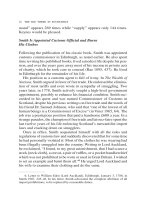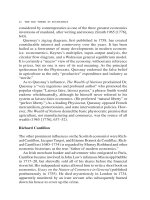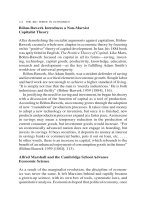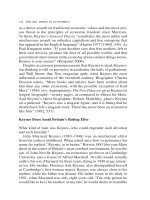The Big Three in Economics
Bạn đang xem bản rút gọn của tài liệu. Xem và tải ngay bản đầy đủ của tài liệu tại đây (2.21 MB, 257 trang )
The Big
Three in
Economics
OTHER ACADEMIC BOOKS
BY MARK SKOUSEN
The Structure of Production
Economics on Trial
Dissent on Keynes
(editor)
The Investor’s Bible:
Mark Skousen’s Principles of Investment
Puzzles and Paradoxes in Economics
(co-authored with Kenna C. Taylor)
Economic Logic
The Power of Economic Thinking
Vienna and Chicago, Friends or Foes?
The Compleated Autobiography by Benjamin Franklin
(editor and compiler)
The Big
Three in
Economics
Adam Smith
Karl Marx and
John Maynard Keynes
Mark Skousen
M.E.Sharpe
Armonk, New York
London, England
Copyright 2007 by Mark Skousen
All rights reserved. No part of this book may be reproduced in any form
without written permission from the publisher, M.E. Sharpe, Inc.,
80 Business Park Drive, Armonk, New York 10504.
Library of Congress Cataloging-in-Publication Data
Skousen, Mark.
The big three in economics : Adam Smith, Karl Marx, and John Maynard Keynes /
Mark Skousen.
p. cm.
Includes bibliographical references and index.
ISBN-10: 0-7656-1694-7 (cloth : alk. paper)
ISBN-13: 978-0-7656-1694-4 (cloth : alk. paper)
1. Economists—History. 2. Economics—Philosophy. 3. Economists—Biography.
4. Smith, Adam, 1723–1790. 5. Marx, Karl, 1818–1883. 6. Keynes, John Maynard,
1883–1946. I. Title.
HB76.S58 2007
330.15092’2--dc22
2006020466
Printed in the United States of America
The paper used in this publication meets the minimum requirements of
American National Standard for Information Sciences
Permanence of Paper for Printed Library Materials,
ANSI Z 39.48-1984.
~
BM (c)
10
9
8
7
6
5
4
3
2
1
Dedicated to
The Big Three in my life,
My editor, my friend, and my wife,
Jo Ann Skousen
Contents
Introduction
Photos follow page 104
Chapter 1. Adam Smith Declares an Economic Revolution
in 1776
ix
3
Chapter 2. From Smith to Marx: The Rise and Fall of
Classical Economics
46
Chapter 3. Karl Marx Leads a Revolt Against Capitalism
64
Chapter 4. From Marx to Keynes: Scientific Economics
Comes of Age
105
Chapter 5. John Maynard Keynes: Capitalism Faces Its
Greatest Challenge
133
Chapter 6. A Turning Point in Twentieth-Century Economics
163
Chapter 7. Conclusion: Has Adam Smith Triumphed Over
Marx and Keynes?
191
Bibliography
Index
About the Author
219
231
243
vii
Introduction
During the past three centuries, three economists stand out as archetypes,
symbols of three distinct approaches to economic philosophy. In the
eighteenth century, Adam Smith, a student of the Scottish Enlightenment, expounded a “system of natural liberty” (what we might term a
liberal democratic order consisting of an unfettered market and limited
government), and elucidated how a nation flourishes and advances the
standard of living of its citizens. In the nineteenth century, the German
philosopher Karl Marx attracted and inspired workers and intellectuals
who felt disenfranchised by industrial capitalism and sought radical solutions to inequality, alienation, and exploitation of the underprivileged.
Finally, in the twentieth century, the British economist John Maynard
Keynes sought to stabilize a crisis-prone market system through activist
fiscal and monetary government policies.
The Pendulum and the Totem Pole
The stories and ideas of these Big Three economists are told in context
of a larger history I have described in greater detail in The Making of
Modern Economics. In the introduction to that work, I describe two
possible approaches to writing about the lives and ideas of economists,
what I term the spectral versus the hierarchal approach.
The most popular method of analysis I describe as a pendulum, by
which historians place each economist somewhere along a political
spectrum, from extreme left to extreme right. Figure A illustrates the
pendulum approach used in many economics textbooks.
The Pendulum Approach to Competing
Economic Theories
Simple though it is, I see several problems with the spectral approach. First, it treats Karl Marx and Adam Smith as coequals, that is,
ix
x
INTRODUCTION
Figure A The Pendulum Approach to Competing Economic Theories
“extreme” in their positions and therefore equally bad. By implication,
neither man’s position is sensible and must be rejected. The result is
a pendulum-like swing between the two extremes, eventually coming
to rest in the middle. Consequently, the moderate, middle-of-theroad position held by John Maynard Keynes appears to be the more
balanced and ideal. But is his system the way to achieve growth and
prosperity? Or is the middle of the road simply the path toward big
government and a cumbersome welfare state?
I suggest as an alternative the “hierarchal” approach. In Indian
folklore, the higher one’s placement on the totem pole, the higher the
rank of significance. Instead of comparing economists horizontally
on a pendulum or spectrum, we might choose to rank them by height
according to the same standard of achievement. Using this totem pole
structure, I would reformulate the diagram according to Figure B.
The Totem Pole of Economics
I have chosen a ranking system consistent with the opinions of most
economists. A large majority of economists and historians of economic
thought consider Adam Smith the greatest of the Big Three. His model
of competitive markets constitutes the “first fundamental theorem of
welfare economics,” what George Stigler called the “crown jewel”
of economics, the “most important substantive proposition in all of
economics” (Stigler 1976, 1201).
Next on the list is John Maynard Keynes. Despite substantial
criticism of the Keynesian model, it continues to endure as a macroeconomic model in institutional analysis and policy matters. As a
defender of bourgeois values, Keynes supported individual liberty,
but on a larger scale, he thought that macroeconomic intervention is
INTRODUCTION xi
Figure B The Totem Pole Approach: The Ranking of Three Economists
(Smith, Keynes, and Marx) According to Economic Freedom
and Growth
essential to stabilize the economy, a view still held by many economists today.
The third man on the totem pole is Karl Marx. Although his endorsement of centrally planned command economies at both the micro and
macro level has been largely discredited, Marxist interpretations of
class conflict and economic crisis still draw the attention of sociologists, historians, and economists.1
The story of modern economics can be told through the eyes of the
Big Three. I have added vital transitional chapters between the three
biographies to complete the story. As you will see, it is a cunning plot
that has many unexpected twists and turns. Let us begin.
1. Those radical economists who take issue with my ranking of Marx as “low
man” on the totem pole may take comfort in the argument made by some experts in
Indian folklore who claim that the figure on the bottom may in fact be the founder
or most significant chief in the history of the tribe.
The Big
Three in
Economics
1
Adam Smith Declares an
Economic Revolution in 1776
Adam Smith was a radical and a revolutionary in his time—just
as those of us who preach laissez faire are in our time.
—Milton Friedman (1978, 7)
The story of modern economics begins in 1776. Prior to this famous
date, 6,000 years of recorded history had passed without a seminal
work being published on the subject that dominated every waking
hour of practically every human being: making a living.
For millennia, from Roman times through the Dark Ages and the
Renaissance, humans struggled to survive by the sweat of their brow,
often only eking out a bare existence. They were constantly guarding
against premature death, disease, famine, war, and subsistence wages.
Only a fortunate few—primarily rulers and aristocrats—lived leisurely
lives, and even those were crude by modern standards. For the common
man, little changed over the centuries. Real per capita wages were
virtually the same, year after year, decade after decade. During this
3
4 THE BIG THREE IN ECONOMICS
age, when the average life span was a mere forty years, the English
writer Thomas Hobbes rightly called the life of man “solitary, poor,
nasty, brutish, and short” (1996 [1651], 84).
1776, a Prophetic Year
Then came 1776, when hope and rising expectations were extended
to the common workingman for the first time. It was a period known
as the Enlightenment, which the French called l’age des lumieres.
For the first time in history, workers looked forward to obtaining a
basic minimum of food, shelter, and clothing. Even tea, previously a
luxury, had become a common beverage.
The signing of America’s Declaration of Independence on July
4 was one of several significant events of 1776. Influenced by John
Locke, Thomas Jefferson proclaimed “life, liberty, and the pursuit of
happiness” to be inalienable rights, thus establishing the legal framework for a struggling nation that would eventually become the greatest economic powerhouse on earth, and providing the constitutional
foundation of liberty that was to be imitated around the world.
A Monumental Book Appears
Four months earlier, an equally monumental work had been published
across the Atlantic in England. On March 9, 1776, the London printers
William Strahan and Thomas Cadell released a 1,000–page, two-volume
work entitled An Inquiry into the Nature and Causes of the Wealth of Nations. It was a fat book with a long title destined to have gargantuan global
impact. The author was Dr. Adam Smith, a quiet, absent-minded professor
who taught “moral philosophy” at the University of Glasgow.
The Wealth of Nations was the intellectual shot heard around the
world. Adam Smith, a leader in the Scottish Enlightenment, had put
on paper a universal formula for prosperity and financial independence
that would, over the course of the next century, revolutionize the way
citizens and leaders thought about and practiced economics and trade. Its
publication promised a new world—a world of abundant wealth, riches
beyond the mere accumulation of gold and silver. Smith promised that
new world to everyone—not just the rich and the rulers, but the common
man, too. The Wealth of Nations offered a formula for emancipating
ADAM SMITH DECLARES A REVOLUTION 5
Figure 1.1 The Rise in Real per Capita Income, United Kingdom,
1100–1995
Income of England (1100–1995)
18,000
GDP per Capita (1990 $)
16,000
14,000
12,000
10,000
8,000
6,000
4,000
Wealth of Nations
published (1776)
2,000
0
1100
1200
1300
1400
1500
1600
1700
1800
1900
1995
Courtesy of Larry Wimmer, Brigham Young University.
the workingman from the drudgery of a Hobbesian world. In sum, The
Wealth of Nations was a declaration of economic independence.
Certain dates are turning points in the history of mankind. The year
1776 is one of them. In that prophetic year, two vital freedoms were
proclaimed—political liberty and free enterprise—and the two worked together to set in motion the Industrial Revolution. It was no accident that the
modern economy began in earnest shortly after 1776 (see Figure 1.1).
The Enlightenment and the Rumblings of
Economic Progress
The year 1776 was significant for other reasons as well. For example,
it was the year the first volume of Edward Gibbon’s classic work,
History of the Decline and Fall of the Roman Empire (1776–88),
appeared. Gibbon was a principal advocate of eighteenth-century
Enlightenment, which embodied unbounded faith in science, reason,
and economic individualism in place of religious fanaticism, superstition, and aristocratic power.
To Smith, 1776 was also an important year for personal reasons.
6 THE BIG THREE IN ECONOMICS
His closest friend, David Hume, died. Hume, a writer and philosopher, was a great influence on Adam Smith (see “Pre-Adamites”
in the appendix to this chapter). Like Smith, he was a leader of the
Scottish Enlightenment and an advocate of commercial civilization
and economic liberty.
For centuries, the average real wage and standard of living had
stagnated, while almost a billion people struggled against the harsh
realities of daily life. Suddenly, in the early 1800s, just a few years
after the American Revolution and the publication of The Wealth of
Nations, the Western world began to flourish as never before. The spinning jenny, power looms, and the steam engine were the first of many
inventions that saved time and money for enterprising businessmen
and the average citizen. The Industrial Revolution was beginning to
unfold, real wages started climbing, and everyone’s standard of living, rich and poor, began rising to unforeseen heights. It was indeed
the Enlightenment, the dawning of modern times, and people of all
walks of life took notice.
Advocate for the Common Man
Just as George Washington was the father of a new nation, so Adam
Smith was the father of a new science, the science of wealth. The great
British economist Alfred Marshall called economics the study of “the
ordinary business of life.” Appropriately, Adam Smith would have an
ordinary name. He was named after the first man in the Bible, Adam,
which means “out of many,” and his last name, Smith, signifies “one
who works.” Smith is the most common surname in Great Britain.
The man with the pedestrian name wrote a book for the welfare of
the average working man. In his magnum opus, he assured the reader
that his model for economic success would result in “universal opulence which extends itself to the lowest ranks of the people” (1965
[1776], 11).1
1. All quotes from The Wealth of Nations are from the Modern Library edition
(Random House, 1937, 1965, 1994). In this book I refer to the 1965 edition, which
has an introduction by Max Lerner. There have been many editions of The Wealth
of Nations, including the official edition issued by the University of Glasgow Press,
but this edition is the most popular.
ADAM SMITH DECLARES A REVOLUTION 7
It was not a book for aristocrats and kings. In fact, Adam Smith
had little regard for the men of vested interests and commercial
power. His sympathies lay with the average citizens who had been
abused and taken advantage of over the centuries. Now they would
be liberated from sixteen-hour-a-day jobs, subsistence wages, and a
forty-year life span.
Adam Smith Faces a Major Obstacle
After taking twelve long years to write his big book, Smith was
convinced he had discovered the right kind of economics to create
“universal opulence.” He called his model the “system of natural liberty.” Today economists call it the “classical model.” Smith’s model
was inspired by Sir Isaac Newton, whose model of natural science
Smith greatly admired as universal and harmonious.
Smith’s biggest hurdle would be convincing others to accept his
system, especially legislators. His purpose in writing The Wealth of
Nations was not simply to educate, but to persuade. Very little progress
had been achieved over the centuries in England and Europe because of
the entrenched system known as mercantilism. One of Adam Smith’s
main objectives in writing The Wealth of Nations was to smash the
conventional view of the economy, which allowed the mercantilists to
control the commercial interests and political powers of the day, and
to replace it with his view of the real source of wealth and economic
growth, thus leading England and the rest of the world toward the
“greatest improvement” of the common man’s lot.
The Appeal of Mercantilism
Following a long-standing tradition in the West, the mercantilists (the
commercial politicos of the day) believed that the world’s economy
was stagnant and its wealth fixed, so that one nation grew only at the
expense of another. The economies of civilizations from ancient times
through the Middle Ages were based on either slavery or several forms
of serfdom. Under either system, wealth was largely acquired at the
expense of others, or by the exploitation of man by man. As Bertrand
de Jouvenel observes, “Wealth was therefore based on seizure and
exploitation” (Jouvenel 1999, 100).
8 THE BIG THREE IN ECONOMICS
Consequently, European nations established government-authorized monopolies at home and supported colonialism abroad, sending agents and troops into poorer countries to seize gold and other
precious commodities.
According to the established mercantilist system, wealth consisted
entirely of money per se, which at the time meant gold and silver. The
primary goal of every nation was always to aggressively accumulate
gold and silver, and to use whatever means necessary to do so. “The
great affair, we always find, is to get money,” Smith declared in The
Wealth of Nations (398).
How to get more money? The growth of nations was predatory.
Nations such as Spain and Portugal sent their emissaries to faraway
lands to discover gold mines and to pile up as much of the precious
metal as they could. No expedition or foreign war was too expensive
when it came to their thirst for bullion. Other European countries,
imitating the gold seekers, frequently imposed exchange controls,
forbidding, under the threat of heavy penalties, the export of gold
and silver.
Second, mercantilists sought a favorable balance of trade, which
meant that gold and silver would constantly fill their coffers. How?
“The encouragement of exportation, and the discouragement of
importation, are the two great engines by which the mercantilist
system proposes to enrich every country,” reported Smith (607).
Smith carefully delineated the host of high tariffs, duties, quotas,
and regulations that aimed at restraining trade. Ultimately, this
system also restrained production and a higher standard of living.
Such commercial interferences naturally led to conflict and war
between nations.
Smith Denounces Trade Barriers
In a direct assault on the mercantile system, the Scottish philosopher
denounced high tariffs and other restrictions on trade. Efforts to promote a favorable balance of trade were “absurd,” he declared (456).
He talked of the “natural advantages” one country has over another in
producing goods. “By means of glasses, hotbeds, and hotwalls, very
good grapes can be raised in Scotland,” Smith said, but it would cost
thirty times more to produce Scottish wine than to import wine from
ADAM SMITH DECLARES A REVOLUTION 9
France. “Would it be a reasonable law to prohibit the importation
of all foreign wines, merely to encourage the making of claret and
burgundy in Scotland?” (425).
According to Smith, mercantilist policies merely imitate real prosperity, benefiting only the producers and the monopolists. Because
it did not benefit the consumer, mercantilism was antigrowth and
shortsighted. “In the mercantile system, the interest of the consumer
is almost always constantly sacrificed to that of the producer,” he
wrote (625).
Smith argued that trade barriers crippled the ability of countries to
produce, and thus should be torn down. An expansion of trade between
Britain and France, for example, would enable both nations to gain.
“What is prudence in the conduct of every private family, can scarce
be folly in that of a great kingdom,” declared Smith. “If a foreign
country can supply us with a commodity cheaper than we ourselves
can make it, better buy it of them” (424).
Real Source of Wealth Revealed
The accumulation of gold and silver might have filled the pockets of
the rich and the powerful, but what would be the origin of wealth for
the whole nation and the average citizen? That was Adam Smith’s
paramount question. The Wealth of Nations was not just a tract on
free trade, but a world view of prosperity.
The Scottish professor forcefully argued that the keys to the “wealth
of nations” were production and exchange, not the artificial acquisition of gold and silver at the expense of other nations. He stated,
“the wealth of a country consists, not of its gold and silver only, but
in its lands, houses, and consumable goods of all different kinds”
(418). Wealth should be measured according to how well people are
lodged, clothed, and fed, not according to the number of bags of gold
in the treasury. In 1763, he said, “the wealth of a state consists in the
cheapness of provisions and all other necessaries and conveniences
of life” (1982 [1763], 83).
Smith began his Wealth of Nations with a discussion of wealth.
He asked, what could bring about the “greatest improvement in the
productive powers of labour”? A favorable balance of trade? More
gold and silver?
10 THE BIG THREE IN ECONOMICS
No, it was a superior management technique, “the division of labor.”
In a well-known example, Smith described in detail the workings of
a pin factory, where workers were assigned eighteen distinct operations in order to maximize the output of pins (1965 [1776], 3–5).
This stages-of-production approach, where management works with
labor to produce goods and fulfill consumer wants, forms the basis of
a harmonious and growing economy. A few pages later, Smith used
another example, the woolen coat: “the assistance and co-operation
of many thousands” of laborers and various machinery from around
the world were required to produce this basic product used by the
“day-laborer”2 (11–12). Furthermore, expanding the market through
worldwide trade would mean that specialization and division of labor
could also expand. Through increased productivity, thrift, and hard
work, the world’s output could increase. Hence, wealth was not a fixed
quantity after all, and countries could grow richer without harming
or exploiting others.
Smith Discovers the Key to Prosperity
How can production and exchange be maximized and thereby encourage the “universal opulence” and the “improvement of the productive power of labor”? Adam Smith had a clear answer: Give people
their economic freedom! Throughout The Wealth of Nations, Smith
advocated the principle of “natural liberty,” the freedom to do what
one wishes with little interference from the state. It encouraged the
free movement of labor, capital, money, and goods. Moreover, said
Smith, economic freedom not only leads to a better material life, but
is a fundamental human right. To quote Smith: “To prohibit a great
people . . . from making all that they can of every part of their own
produce, or from employing their stock and industry in the way that
they judge most advantageous to themselves, is a manifest violation
of the most sacred rights of mankind” (549).
Under Adam Smith’s model of natural liberty, wealth creation was
2. This passage in the first chapter of The Wealth of Nations is remarkably similar to the theme developed by Leonard Read in his classic essay, “I, Pencil,” which
describes how a simple product like the pencil involved production processes from
around the world (Read 1999 [1958]).
ADAM SMITH DECLARES A REVOLUTION 11
no longer a zero-sum game. No longer was there a conflict of interests,
but a harmony of interests. According to Jouvenel, this came as an
“enormous innovation” that greatly surprised European reformers.
“The great new idea is that it is possible to enrich all the members
of society, collectively and individually, by gradual progress in the
organization of labor” (Jouvenel 1999, 102). This development could
be rapid and unlimited.
Here was something that could capture the imagination and hope
not only of the English worker, but of the French peasant, the German laborer, the Chinese day worker, and the American immigrant,
for Smith was advocating a worldwide principle of abundance. The
freedom to work could liberate everyone from the chains of daily
chores.
What constitutes this new economic freedom? Natural liberty includes, according to Smith, the right to buy goods from any source,
including foreign products, without the restraints of tariffs or import
quotas. It includes the right to be employed in whatever occupation
a person wants and wherever desired. Smith trenchantly criticized
European policy in the eighteenth century wherein laborers had to
obtain government permission (via certificates) to move from one
town to another, even within a country (1965 [1776], 118–43).
Natural liberty also includes the right to charge whatever wage
the market might bear. Smith strongly opposed the state’s efforts to
regulate and artificially raise wages. He wrote, “Whenever the law has
attempted to regulate the wages of workmen, it has always been rather
to lower them than to raise them” (131). Like every worker, Smith
desired high wages, but he thought they should come about through
the natural workings of the labor market, not government edict.
Finally, natural liberty includes the right to save, invest, and accumulate capital without government restraint—important keys to
economic growth.
Adam Smith endorsed the virtues of thrift, capital investment, and
labor-saving machinery as essential ingredients to promote rising
living standards (326). In his chapter on the accumulation of capital
(Chapter 3, Book II) in The Wealth of Nations, Smith emphasized
saving and frugality as keys to economic growth, in addition to stable
government policies, a competitive business environment, and sound
business management.
12 THE BIG THREE IN ECONOMICS
Smith’s Classic Work Receives Universal Acclaim
Adam Smith’s eloquent advocacy of natural liberty fueled the minds
of a rising generation. His words literally changed the course of
politics, dismantling the old mercantilist doctrines of protectionism
and enforced labor. Much of the worldwide movement toward free
trade can be attributed to Adam Smith’s work. The Wealth of Nations
was the ideal document to usher in the Industrial Revolution and the
political rights of man.
Smith’s magnum opus has received almost universal acclaim. H.L.
Mencken stated, “There is no more engrossing book in the English
language” (in Powell 2000, 251). Historian Arnold Toynbee asserted
that “The Wealth of Nations and the steam engine destroyed the old
world and built a new one” (in Rashid 1998, 212). The English historian Henry Thomas Buckle stretched the hyperbole even further to
claim that, in terms of its ultimate influence, Smith’s tome “is probably
the most important book that has ever been written,” not excluding the
Bible (in Rogge 1976, 9); and Paul A. Samuelson placed Smith “on
a pinnacle” among economists (Samuelson 1962, 7).3 Even Marxists
sometimes extol the virtues of Adam Smith.
The Life of Adam Smith
Who was Adam Smith, and how did he come to write his revolutionary work on modern economics?
Seaports and commerce were an integral part of Adam Smith’s life.
Born in Kirkcaldy, on the east coast of Scotland near Edinburgh, in
June 1723, he had the unfortunate distinction of coming into the world
in the same year that his father died. It appeared that the newborn
Adam Smith was destined to be a student of trade and a customs agent.
His father, also named Adam Smith, was a comptroller of customs at
Kirkcaldy. His guardian, named Adam Smith as well, was a customs
collector in the same town, and a cousin served as customs inspector
in Alloa. The cousin’s name was—you guessed it—Adam Smith.
3. This was Samuelson’s presidential address before the American Economic
Association. A year later, Samuelson declared, “The first human was Adam. The
first economist . . . was Adam Smith” (Samuelson 1966,1408).









